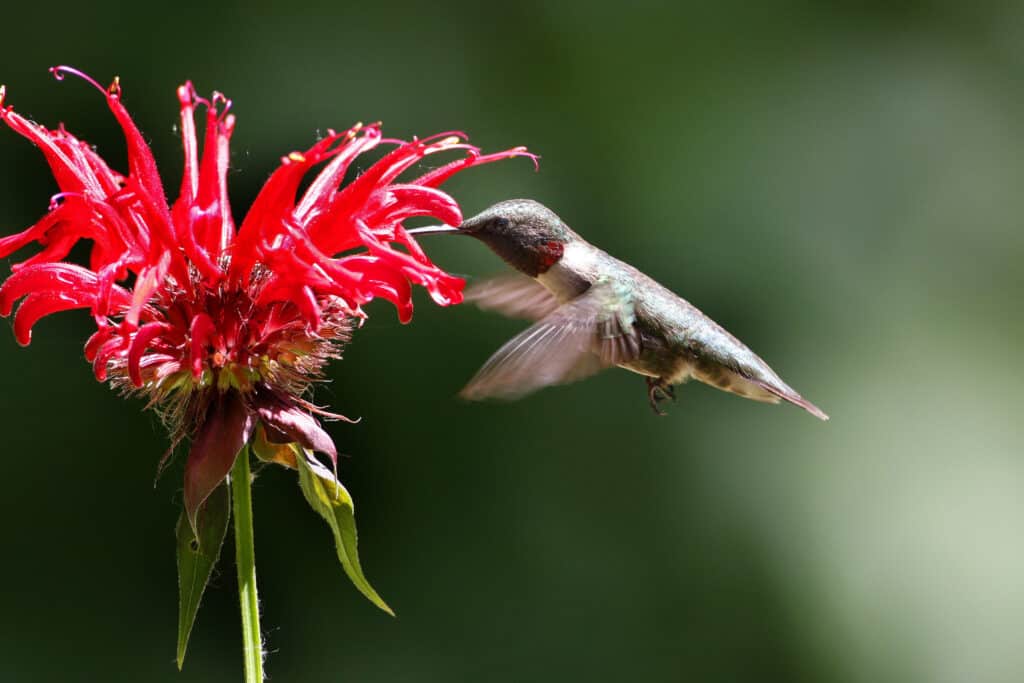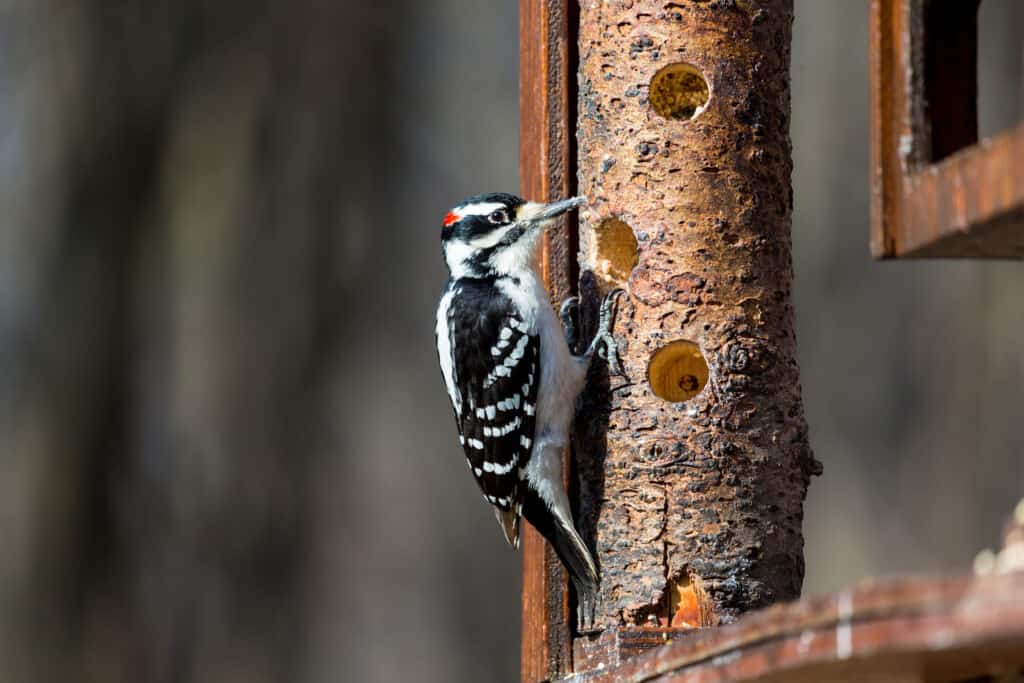Animals everywhere have unique adaptations that allow them to adjust and thrive in their environments. Some of those adaptations include wacky body parts that serve a purpose, such as a shoebill stork’s massive bill or the proboscis monkey’s strange-looking nose. Or, in the case of some birds, extremely long tongues. That’s right! Hummingbirds and woodpeckers can lick their own brains. Find out how and why.
Do Hummingbird Tongues Wrap Around Their Brain?

Hummingbirds can extend their tongues to about two times their bill length.
©Chris Alcock/Shutterstock.com
Yes! Hummingbird tongues wrap around their skull when not in use.
Hummingbirds can extend their tongues to about two times their bill length. They use their long, forked tongues to drink flower nectar, which rapidly flicks in and out 12 times per second. After the hummingbird finishes its meal, it needs somewhere to store this long appendage. As it retracts, the tongue wraps around the jaw, behind, and over its head. It encompasses the skull, resting on a structure called a hyoid apparatus.
The hyoid apparatus consists of two bones that wrap around the skull and attach to the base of the upper bill. The structure essentially supports the tongue and allows it to extend deep into flowers. They can also protrude their tongues with their bills closed due to a plastic envelope between the larynx and the tongue base, allowing it to lengthen without dragging the trachea inside the bill.
Hummingbirds have remarkable modes of feeding. Flower nectar comprises half of their diet, which is collected inside tongue grooves. Once inside the flower, the forked tongue separates, and the grooves slightly extend out. And as the tongue rolls in, the tips come together, and the grooves roll inward, trapping the nectar within the tongue. The second half of their diet consists of arthropods, which most hummingbird species capture by flycatching, using the base of their tongue to collect their prey.
Now that you know all about hummingbird tongues and how they are stored, let’s break for some fun facts!
Interesting Facts About Hummingbirds?
- Their names might insinuate that they can hum, but it actually refers to the buzzing sound their wings make as they rapidly beat.
- Hummingbirds have an average weight of less than a nickel, and their eggs are no bigger than a coffee bean.
- Hummingbirds are the smallest migrating bird, traveling hundreds of miles at a time. They also don’t flock with other birds and prefer to make these journeys alone.
- Despite their tiny size, hummingbirds are fierce defenders of their nests. And they will regularly attack intruders much larger than them, such as crows and jays.
- Hummingbirds are the only bird species that can fly backward.
Do Woodpeckers Put Their Tongues Around Their Brains?

Woodpeckers use their bills to drill into tree trunks for bugs, larvae, and sap.
©Glass and Nature/Shutterstock.com
They do! But for a different purpose than the hummingbird.
Woodpeckers use their bills to drill into tree trunks for bugs, larvae, and sap. They also excavate trees for their nests and use pecking as a form of communication. When pecking, their head hits the wood 20 times per second at over 1200 g’s of force. And they do this over 1200 times a day. No human could withstand that amount of force and repetitiveness without brain damage.
Woodpeckers themselves can’t withstand their own pecking without special adaptations. They have tiny brains with extra gray matter, spongy skulls, and cranium muscles that connect to their bills, all of which are designed to absorb shock. So, where does the tongue come into play?
The woodpecker’s tongue stretches almost four inches beyond its bill and accounts for one-third of its body length. Like hummingbirds, woodpeckers have a hyoid apparatus, a wiry Y-shaped structure featuring flexible cartilage. The structure allows the tongue to rest coiled around the skull and extend to probe into tree holes. But, for woodpeckers, their extended coiled tongues act as cushioning for their brains as they peck at hard surfaces. Their specially designed anatomy supports these birds, absorbing shock and protecting their brains.
Check out these fascinating woodpecker facts before you go!
Interesting Facts About Woodpeckers
- Woodpeckers have other specialized body features to help them thrive in their environments. Their strong tail feathers help them cling to trees, and their furry noses keep out wood splinters and dust as they peck.
- Woodpeckers use soft, rotting wood to carve perfect circles for their nests. They are a bit of a perfectionist!
- When woodpeckers are not drilling, they’re drumming. These birds drum on trees to attract mates and communicate with one another.
- Woodpeckers can tell where to drill their holes by listening to insects crawling inside trees.
- Woodpeckers have unique toes: two facing forward and two backward. This arrangement is called zygodactylism and allows them to move up and down trees.
The photo featured at the top of this post is © Takahashi Photography/Shutterstock.com
Sources
- Attracting and Studying Hummingbirds, Available here: https://resources4rethinking.ca/media/Attracting%20and%20Studying%20Hummingbirds.pdf
- Science Direct, Available here: https://www.sciencedirect.com/science/article/abs/pii/S014067367691477X
- ZSL, Available here: https://zslpublications.onlinelibrary.wiley.com/doi/abs/10.1111/j.1469-7998.2006.00166.x
- National Library of Medicine, Available here: https://www.ncbi.nlm.nih.gov/pmc/articles/PMC5466813/
- National Library of Medicine, Available here: https://www.ncbi.nlm.nih.gov/pmc/articles/PMC5466813/#ref-102
Thank you for reading! Have some feedback for us? Contact the AZ Animals editorial team.






